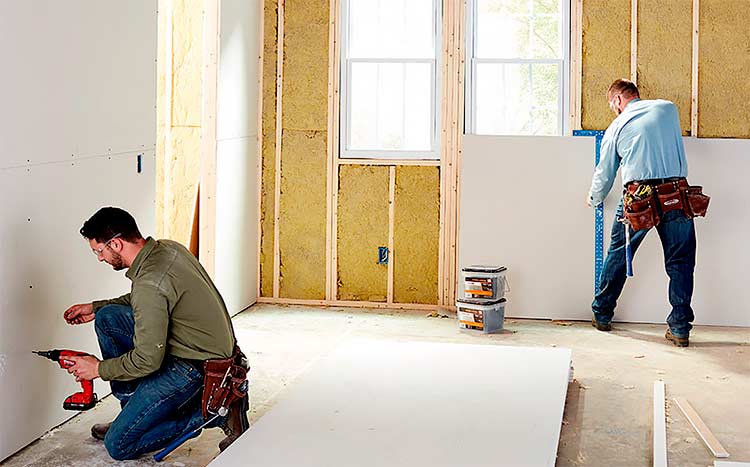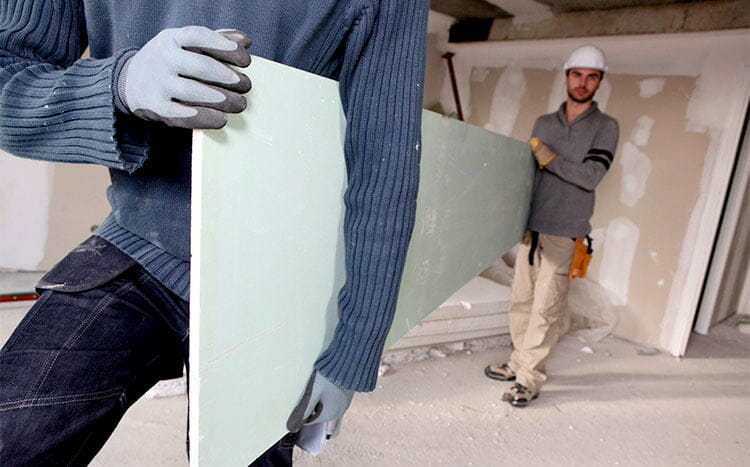USG led the way in the development of drywall in 1916 and provides an array of drywall choices in various dimensions and thickness levels. Consisting of several layers of compressed gypsum or concrete, they are encased between two sturdy sheets of paper or reinforced fiberglass.
Sheetrock and drywall are related products. They have identical characteristics and perform similar functions. Builders use both materials for the same purpose.
Sheetrock is a USG product, and it is essentially a drywall spin-off. They are near identical and share similar features. Both construction materials are also known as wallboard, gypsum board, plasterboard, and gyproc.

What is drywall?
Drywall, also known as gypsum board, is a durable construction material that was invented as a time-saving substitute for plaster, and it is used for covering:
- Partition (non-load bearing) walls and ceilings.
- Columns with exposed steel beams.
- Design features like arches and eaves.
Drywall offers the following benefits:
- Time-saving construction of finished interior walls and ceilings for your home.
- Durable and uniformly smooth surface for your home interior walls.
- Inexpensive and high-quality partitioning for your home interior.
- Soundproofing.
- Fire protection.
- Water resisting benefits.
Drywall is available in a wide range of types and textures to suit your needs. Specialty drywall types are created by mixing extra agents and additives to produce drywall with unique properties that builders use for special applications.
Drywall vs. plaster.
Both drywall and plaster are standard home interior finishing options available to homeowners. However, the two methods have different characteristics, costs, and market segments. They both offer high-quality interior coating and finish choices accompanied by an excellent long-term value, making choosing between either drywall or plaster very difficult.
To highlight the differences between both methods, we have selected five significant differences.
Cost
Wall plastering is more expensive than installing drywall due to its significantly higher labor costs. The reason for the higher price for plaster is the laborious and time-consuming plastering process. In contrast, the process of installing drywall sheets is faster when performed by a skilled professional. Also, tradespeople who specialize in plaster application are in short supply compared to drywall professionals, and they often charge higher labor rates than drywall pros.
Durability
Without a doubt, plaster is a more durable construction material than drywall. Homeowners who choose plaster over drywall do so because of its exceptional longevity, soundproofing, fire, and moisture-resistant attributes. Plaster prevents the growth of mold. However, exposure to water causes the growth of mold and mildew on drywall.
Design and aesthetics
Plaster is a high-end construction material compared to drywall. Builders often use plaster to achieve a premium quality finish of exceptional elegance on walls and ceilings.
Versatility
Although builders use drywall for different wall and ceiling applications, it is quite limited in its range. For example, hanging drywall on your home’s exterior walls is not encouraged, but plaster can be used for many interior and exterior applications. Aside from being a protective coating material, plaster can also be applied as a decorative material on walls, ceilings, arches, beams, and trims.
Repairs
This is where drywall really shines. The drywall is easily repaired with minimal costs. Replacing damaged drywall is an ideal DIY job. However, repairing damaged plaster walls and ceilings requires a lengthy and expensive repair process.
Difference between Drywall and Durock
Unlike regular drywall, durock is a unique application cement board made from concrete and fiberglass mesh for extra thickness and strength. Although both regular drywall and durock cement boards are suitable for home applications, they are different in composition, capabilities, characteristics, and sizes.
The differences are listed below.
- Cost: The average price of a regular 4×8 feet, ½-inch thick drywall is $15 per panel. In contrast, the average price of a 5/8 x 4′ x 8′ durock cement board is $22 per sheet.
- Water-resistance: durock is rated for use as a concrete tile backer board in areas with high moisture levels. Its reinforced fiberglass mesh wrapping offers better water resistance in bathrooms compared to water or mold-resistant drywall. Durock’s unique design guarantees against rot, warping, and mold growth. Unlike drywall, durock doesn’t disintegrate when exposed to water.
- Size: drywall panels are typically made in 4 by 8 feet sheets. On the other hand, durock sheets are usually 3 by 5 feet panels for easy fitting in showers and bathtubs.
- Versatility: although both drywall and durock panels can be adapted for a wide range of purposes, there are still differences. While drywall and durock sheets are used to cover walls, ceilings, beams, and arches, durock sheets can also be used for vertical shelving and kitchen countertops.
- Installation: durock shares a similar installation process with drywall. However, the big difference is in using thin-set mortar to attach durock panels rather than using a regular drywall joint compound, also, unlike drywall which can be fitted to frames with regular nails. Special screws made explicitly for cement boards must attach durock panels to the underlying wooden or metal structure.
What is a cheap alternative to drywall?
Although cheaper drywall alternatives are hard to come by, plywood currently happens to be the closest interior paneling option in terms of price. It is a tad costlier than drywall but cheaper than regular wood. Plywood offers several benefits when used for interior wall and ceiling paneling.
What thickness does drywall come in?
Drywall is produced in a variety of sizes and thicknesses for different purposes. Standard drywall is ½ inch thick, but homeowners can purchase thinner or thicker drywall. When considering drywall for a particular project, your first task is to determine if the drywall thickness is adequate for the job.
Here is a quick guide.
Standard Walls
Drywall thickness: ½ inch.
Drywall used in interior wall construction typically comes in ½ inch-thick panels, and it is installed on walls with studs spaced 16 inches in the center. This thickness works best with pre-hung doors, and contractors often recommend it for a fast and easy installation. However, in situations where wall studs are spaced 24 inches in the center, use a ⅝ inch drywall for easier installation.
Fire Resistance
Drywall thickness: ½ – ⅝ inch.
Fire-resistant drywall is mandated for use in areas requiring a fire rating. For example, covering furnace areas in the home or partitioning units in residential blocks. Fire-resistant drywall is available in two thicknesses, namely;
⅝ inch panels with a 60 minutes fire rating.
½ inch panels with a 30-minute fire rating.
Curved Walls
Drywall thickness: ¼ – ⅜ inch.
When covering round columns, or arches, you need thin and flexible drywall that comes in ¼ or ⅜ inch thickness. These types of drywall can be bent over curved interior surfaces and yet retain their structural integrity.
Wall Repairs
Drywall thickness: ¼ – ⅜ inch.
When performing repairs on damaged drywall or interior plaster walls, thin drywall with a thickness range of ¼ to ⅜ inch is recommended.

How much does it cost to hang drywall?
It costs between $1 to $2 per square foot to hang the drywall. However, prices are determined by the size and scope of the project and the quality of materials. Most homeowners report paying between $2 – $3 per square foot to hire a professional to install drywall. A DIY drywall installation costs range between $0.50 – $0.75 per square foot for materials. Additional drywall finishes or texturing may cost between $0.50 – $1.50
Certain cost factors can influence your overall installation costs. These include:
- The age of the home. Houses built before the 1970s may contain lead paint or asbestos used in the drywall used in construction.
- Special decorative features, such as arches, rounded wall edges, and columns.
- Utility upgrades and other necessities are required before installing new drywall.
What are the different types of drywall and sheetrock?
Different types of drywall are produced for use in specific areas around your home. Below is a list of some of the drywall types.
Green Board
Green board drywall is a popular name for water-resistant gypsum drywall designed for walls in humid or damp rooms in a building. It derives its name from the greenish protective paper coating covering the gypsum slab. This paper coating is covered with a wax layer that gives Green board better moisture resistance abilities than regular drywall. However, the Green board isn’t waterproof, and it will deteriorate when exposed to direct contact with water. Green board is available in ½-inch and ⅝ inch thicknesses.
Acoustic drywall
This is a particular type of drywall consisting of gypsum, wood fibers, and polymers. Acoustic drywall is denser than regular dry wood, and as a result, it has a higher STC (sound transmission class). Acoustic drywall is designed for use in areas where silence is required, often used for soundproofing.
Fire resistant
This is commonly known as Type X drywall. This fire-resistant drywall consists of non-combustible fibers that give it a fire rating of up to an hour. It is typically sold in ⅝ inch thickness, although ½ inch fire-resistant drywall is also available. Fire-resistant drywall is required for apartment buildings, and it can also be used in garages and around fireplaces.
Durock
Durock is a brand name for a type of cement backer board manufactured by the USG Corporation, the same company that makes Sheetrock. Durock consists of a concrete core sandwiched between two fiberglass mesh coatings, and it is available in two sizes in a 4 by 4 feet panel with ⅚ inch thickness and a 3 by 5 feet panel with ½-inch thickness. Durock panels are fire and water-resistant, and the material is suitable for use in bathrooms, saunas, or pool areas.
FAQ's
How much does a sheet of drywall weigh?
Certain factors may influence drywall weight. These are the drywall type and thickness. For example, fire and water-resistant drywall are heavier than regular drywall. A regular ½ inch drywall used for interior walls weighs around 1.6 pounds per square foot, while the average weight of a 4 x 8 feet drywall with ½ inch thickness is about fifty-seven pounds. A fire-rated Type X drywall with ⅝ inch thickness has an average weight of seventy pounds. Larger 4 x 12 feet sheets typically weigh around one hundred and twenty-five pounds.
Do you drywall the ceiling or walls first?
Professionals recommend that you drywall ceilings before walls. This approach is preferred because it helps to create the right joints, clean finishes, and ensure longer-lasting jobs which you can repair quickly.
Is sheetrock waterproof?
No, it isn’t. Water-resistant gypsum sheetrock or drywall varieties have moisture-absorbing capabilities that allow their use in damp areas with higher than average moisture levels. However, it is not waterproof.
Is plywood cheaper than sheetrock?
No, plywood isn’t cheaper than drywood. While plywood is less expensive than most wood-based wall paneling, it is more expensive than drywall and costs more money to repair. Drywood remains the cheapest construction material for covering your home interior.
Is it better to drywall vertically or horizontally?
On commercial projects, fire codes may require vertical installation of drywall. You can hang drywall vertically in ceilinged rooms. However, drywall is often hung horizontally in living areas with walls that are less than nine feet high.







